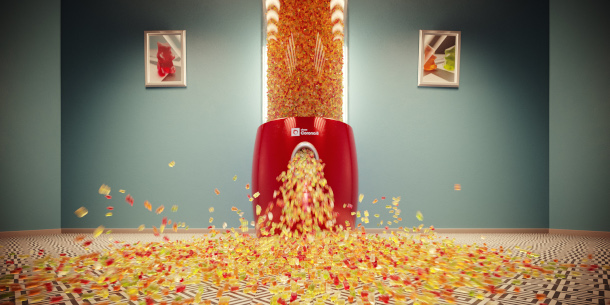Chaos Czech ships Corona 8 for 3ds Max and Cinema 4D
Originally posted on 16 November 2021, and updated with news of the commercial release.
Chaos Czech has previewed released Corona 8, the next major version of its production renderer for 3ds Max and Cinema 4D, officially changing its name from Corona Renderer to Chaos Corona.
The release adds new object scattering, decal and cutaway rendering systems, introduces support for Cryptomatte, and reworks handing of tonemapping.
Chaos Czech is also changing the price of subscriptions to the software, with the cost of annual subscriptions falling, but monthly subscriptions rising, and render licences now charged per node.
Corona Renderer becomes Chaos Corona
First up, that change of name. Corona was the only product not affected when parent company Chaos Group rebranded itself as Chaos earlier this year, so it is now playing catch-up.
As well as now being officially called Chaos Corona, the software gets a new logo in the same format as those of Chaos’s other products like V-Ray and Phoenix.
New Chaos Scatter plugin bundled with the software
New features in the release include Chaos Scatter, a “full featured, production ready” object scattering plugin, bundled with both editions of Corona 8.
Improvements over the existing Corona Scatter system include new options to exclude parts of a scene from receiving scattered objects: either automatically, according to slope angle, or manually, using splines.
The plugin also suports frustum culling, making it possible to limit scattering only to the camera field of view.
New V-Ray-style decal system
Other changes include a new system for projecting decal textures onto surfaces in a scene without the need to set up or modify UVs for a mesh.
As with its V-Ray counterpart – introduced in recent updates to V-Ray 5 – users can control where the decal texture appears in the scene by using a viewport gizmo to adjust its position, size and angle.
It is also possible to selectively exclude scene objects from the texture projection, and to overlap decals. Decals support displacement and motion blur.

New Slicer material, Curvature map and Cryptomatte support
The update introduces a new Slicer material for creating cutaway renders of scene objects, as shown in this video, and a new Curvature map for adding wear effects to the edges of objects.
Corona also becomes the latest renderer to support Cryptomatte, the open-source ID matte generation system originally developed at VFX studio Psyop.
Improvements to existing functionality include a rework of tonemapping in the Virtual Frame Buffer, adding new ACES OT (ACES Output Transform) and Advanced Filmic operators.
Both are intended to apply a traditional filmic or photographic look to renders, with ACES OT being more of an all-in-one solution, and Advanced Filmic providing finer control over output.
Tone mapping operators are also now organised in a stack, making it possible to adjust output by adding, deleting or re-ordering operators.
The update also adds a new Reflection Tail parameter (shown in the image above), for finer control over the look of reflections and refraction.
Cinema 4D edition only: native support for M1 Macs and dome mapping for environments
Cinema 4D users also get support for dome mapping for environment maps: the video above shows a comparison between the new system and Corona’s existing spherical mapping.
In addition, Corona 8 for Cinema 4D introduces native support for Apple’s new M1 processors, resulting in a “45–50% speed increase” compared to running Corona under Apple’s Rosetta emulation system.
Support for Chaos Cosmos, with Chaos Cloud and Scans to come
Corona 8 also integrates the renderer with other services previously only available to V-Ray users.
In the initial release, that means Chaos Cosmos, the firm’s new online library of stock architectural assets, with cloud rendering service Chaos Cloud and material scanning service Chaos Scans to follow.
New licensing system and subscription prices
Chaos Czech is also moving its licensing system to the same backend as the rest of Chaos, and changing the cost of new subscriptions: active subscriptions will continue unchanged.
The cost of a new annual subscription, which currently starts at €289.99/year ($330/year), falls slightly to €280/year ($310/year), although that doesn’t include any render nodes.
Render nodes, which used to be bundled with subscriptions – the price listed above includes three nodes – are now charged separately, with prices starting at €100/year ($110/year) or €36/month ($40/month).
According to Chaos Czech, “over 90%” of Corona users never activate a render node, so that means a reduction in costs for most freelancers with annual subscriptions; and an increase in costs for larger studios.
The cost of monthly subscriptions rises to €40/month ($45/month), up from €25/month ($28.50/month).
In addition, perpetual ‘Box’ licences of the 3ds Max edition will no longer be listed on Chaos Czech’s website, although they will still be available on request.

Updated 13 April 2022: Corona 8 for 3ds Max and Corona 8 for Cinema 4D are now available.
As well as the features covered above, the update adds an include/exclude list for caustics, making it possible to control which objects in a scene receive them, to balance visual quality against render time.
The Layered Material now processes displacement from multiple material layers, rather than just the base layer, and there are new texture randomisation options in the Multimap/Multi Shader system.
In addition, the 3ds Max edition can now render simulations generated using popular particle and multiphysics plugin tyFlow, which got its first official release earlier this year.
The implementation is described as “initial support”, but supports motion blur for rendering animations.
Pricing and system requirements
Corona 8 is available for 64-bit 3ds Max 2014+ running on Windows 7+ and Cinema 4D R14+ running on Windows 7+ or macOS 10.14+. Current pricing is covered in the story above.
Read an overview of the new features in Corona 8 on Chaos Czech’s blog
